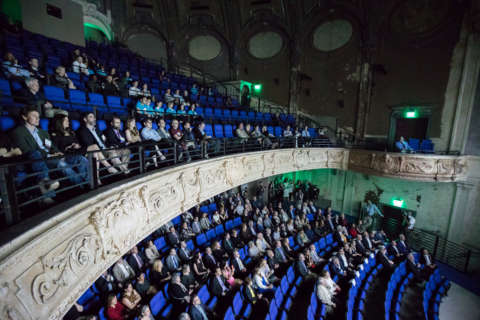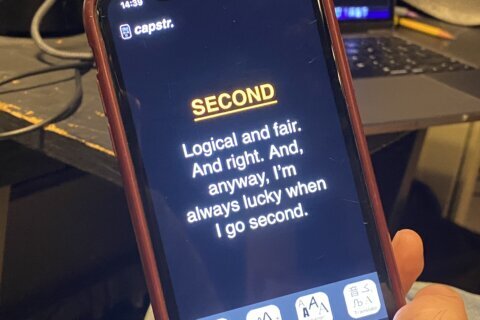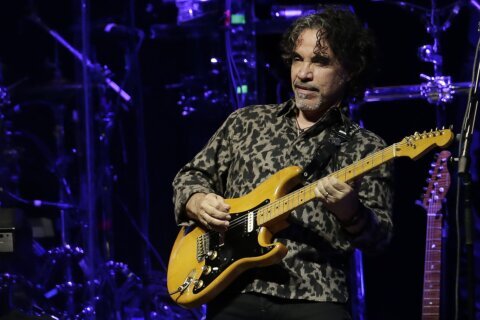WASHINGTON — Hold on to your butts: The superhero box office is about to explode.
Advanced ticket sales are through the roof for Marvel’s “Black Panther,” already breaking the Fandango record for the Marvel Cinematic Universe in what could easily be the biggest February opening ever, with a projected $170 million for the four-day holiday weekend.
Believe the hype: This is a superhero flick unlike any we’ve ever seen, crafted by the unstoppable Ryan Coogler, who won the Sundance Film Festival with the gritty, timely and tragic “Fruitvale Station” (2013) before revamping the Rocky franchise with “Creed” (2015).
Based on the 1966 comic, T’Challa mourns his father’s death as he takes his rightful place as king of Wakanda, a fictional African nation “hiding in plain sight,” just like Wonder Woman’s Themyscira. This high-tech kingdom is known for mining vibranium, a magical mineral that gives T’Challa’s panther suit special powers. But his peaceful reign is challenged when an ex-Navy SEAL named Killmonger arrives from Oakland, California, carrying a childhood grudge.
After playing Jackie Robinson in “42” (2013), James Brown in “Get On Up” (2014) and Thurgood Marshall in “Marshall” (2017), Chadwick Boseman has built himself into a sort of American folk hero. Now, after a cameo in Marvel’s “Civil War” (2016), “Black Panther” finally shows his ability to inhabit a fictional character, adopting an accent and carrying the film with a Shakespearean grace that recalls the time “Hamlet” became “The Lion King” with ghostly father-uncle scars.
On the flip side, Michael B. Jordan instantly becomes one of Marvel’s best villains. The days of asking, “Where’s Wallace?” from “The Wire” (2002) are long gone. Physically, Jordan is a damn specimen, jacked like a body builder and self-branded with “kill marks.” Imagine if “American Sniper” (2014) burned a welt on his body to tally each military kill and you have Killmonger.
More importantly, his character avoids the common trap of being “evil for evil’s sake.” Too often, Marvel villains are out to destroy the world without any explanation, but Jordan is given believable motives for his grudges. An early framing device gives him vengeful desires on a personal level, while broader history fuels his anger over the colonial enslavement of his race. At one point, he mocks the old British empire slogan, saying, “The sun will never set on my empire.” Later, he says he’d rather die than be jailed, saying, “Death is better than bondage.”
These are the finest moments in Coogler’s script, co-written by Joe Robert Cole, who earned an Emmy nod penning the “Race Card” episode of “The People v. O.J. Simpson” (2016). They’re the perfect pair to wade into such social commentary, blowing up stereotypes of third-world nations as “s-hole countries” by crediting them for many of history’s earliest technological advances as the cradle of civilization. The final message of sharing science with the rest of the world is admirable in its forward-looking globalization instead of backward-looking tribalism.

Beyond the social themes, it’s equally important for black viewers to see themselves widely represented on screen. Enter the mostly African-American supporting cast of Oscar winner Lupita Nyong’o (“Twelve Years a Slave”), Emmy winner Sterling K. Brown (“This Is Us”), Oscar nominee Angela Bassett (“What’s Love Got To Do With It?”) and Oscar winner Forest Whitaker (“The Last King of Scotland”), not to mention British Oscar nominee Daniel Kaluuya (“Get Out”).
Still, the real supporting MVPs are Letitia Wright (“Black Mirror”), who recalls James Bond’s Q as gadget guru Shuri, and Danai Gurira (“All Eyez on Me”), who commands our attention as badass warrior Okoye. Let’s also give a shout out to Martin Freeman, who provides comic relief as the white ally, and Andy Serkis, who evolves from his motion-capture Gollum and Caesar to show his charismatic in-person presence with a manic laugh as henchman Klaue.
In fact, it’s a battle sequence with Serkis that allows Coogler to show his directorial chops. Just like his long single-take boxing match at the midpoint of “Creed,” Coogler uses a similar long unbroken take at the midpoint battle with Serkis, starting on the first floor of a South Korean casino and rising fluidly up to the second-story balcony to continue the mesmerizing action.
Of course, the best fight sequences come in Wakanda during ritualistic bouts atop a waterfall, where the sitting king must face any challenger to the throne. As women warriors corral the brawlers with their spears and the entire kingdom watches from the cliffs above, you’ll get vertigo as the camera dangles over the edge and the hero’s safety hangs in the balance.

Staring off these Wakanda cliffs, you’ll take in some truly gorgeous sunrises and sunsets painted by pioneering cinematographer Rachel Morrison, who just became the first woman cinematographer ever nominated for an Oscar in “Mudbound” (2017). In “Black Panther,” she and Coogler create stunning imagery, particularly during the purple-tinged afterlife scenes where characters undergo temporary burial in order to interact with their African ancestors.
It’s hard to tell where the digital backdrops end and actual Georgia shooting locations begin. The same goes for the practical stunts and slow-mo CGI that enhances — not detracts — from a thrilling car chase. The only moment that breaks the illusion is when T’Challa and Killmonger plummet into a pit, punching each other mid-air like a video game, before their final underground battle in a hologram train tunnel. Perhaps this is because it’s intercut with the far more realistic land battles above, but after the gritty trains of “Fruitvale Station,” there’s a hint of blockbuster compromise here.
Thankfully, it’s a very minor blip on an otherwise masterful mix of rousing entertainment and refreshing artistry, blending African cultural artifacts with Afro-pop drums by composer Ludwig Göransson, including original songs by Kendrick Lamar. It’s the past meets the present, making up for all the lost time that this sensibility was missing from Hollywood.
Can you imagine all of the cultural contributions we’ve missed over the last century since Oscar Micheaux made his silent films? Yes, there have been breakthrough black directors — Melvin Van Peebles, Gordon Parks Jr., Spike Lee, John Singleton, Ava DuVernay, Barry Jenkins, Dee Rees — but there have been many more missed opportunities behind the camera.
Thus, Coogler just did for black filmmakers what Patty Jenkins did for women filmmakers in “Wonder Woman” (2017), proving once and for all to financiers what the rest of us have known for decades — that diverse perspectives enhance the box office when executed well.
Let’s face it: Hollywood — like every industry of business — is all about the bottom line. Here’s hoping that “Black Panther” crushes at the box office just like “Wonder Woman,” so that a diverse new wave of filmmakers — young, scrappy and hungry — will finally get their shot.









